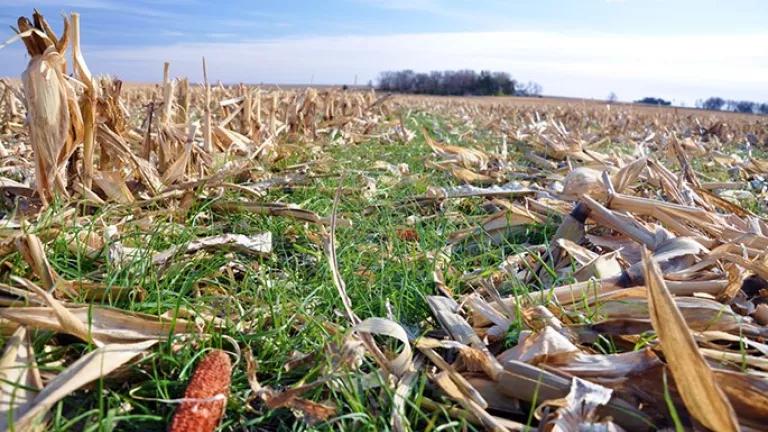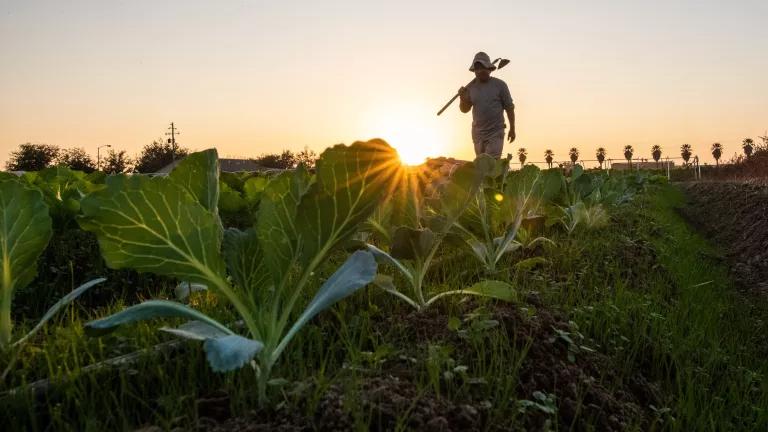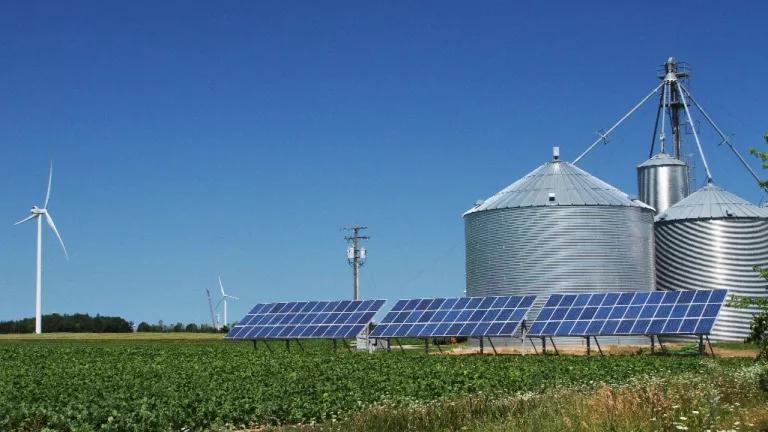Stewardship of Wetlands and Soils Has Climate Benefits
Wetlands and agricultural soils, when managed well, are carbon sinks that can help mitigate climate change and boost other ecosystem services.

Cover crops
When you look at a farm, do you think about nutrient rich soils or cover crops growing between rows? When you look at a marsh, do you see the submerged layers of sediment created by years of plant litter piling up? Probably not. But those parts of well-managed agricultural lands and wetlands store a lot of carbon, and that’s increasingly important as climate change is forcing society to consider ways to lower carbon emissions and draw down existing carbon levels in the atmosphere. Managing landscapes and its components, like plants and soils, to sequester carbon long-term is called natural climate solutions. Several of NRDC’s water-related initiatives, including our work on wetlands and healthy soils, support this type of climate mitigation.
Wetlands
Wetlands have a remarkable capacity to sequester carbon despite covering less land area than other ecosystems, like forests. One reason why these ecosystems accumulate carbon so effectively is that they are water-logged, dark, and very productive, which creates conditions for highly stable carbon content. They store carbon in vegetation above ground and underground, in sediment beneath live plants, and in dead plants, such as leaf litter.
The estimated total carbon storage of wetlands globally is 225 billion metric tons (MT), or the equivalent of carbon emissions from roughly 189 million cars every year—that’s more than the number of registered automobiles in the U.S. in 2015. The stockpile of carbon in wetlands that should be kept sequestered provides a new and urgent reason to save these ecosystems.
But in order to fully realize their benefits, we have to manage our wetlands well. Poorly managed wetlands can be, and often are, sources of carbon when they are destroyed, drained, or encroached upon by development. It can take years for a newly constructed wetland to fully mature, and even then it will never sequester as much carbon as a natural wetland. That’s why we need to preserve the wetlands that we have. Wetlands currently constitute approximately 5-8% of the world’s terrestrial landscape and 4% of the surface area of the contiguous U.S. (excluding Alaska and Hawaii). That number is starkly reduced from the historical amount of wetlands, which used to cover about twice as much land in the U.S. Worse yet, the U.S. is currently losing wetlands at a faster rate than they are being restored to support agriculture, urban expansion, and other developments.
Most wetland area in the U.S. is freshwater inland wetlands, comprising 95% of all wetlands in the country. Prairie potholes, peatlands, swamps, bogs, and fens are all types of freshwater wetlands, and their carbon densities vary. Because they are more common than tidal saltwater wetlands, they hold more carbon as a whole. Freshwater inland sites store 10.7 billion of the estimated 11.5 billion MT of wetland soil carbon in the U.S. A study of freshwater wetlands in Pennsylvania found an average total storage of 70.7 MT of carbon per acre in the wetlands studied. In Georgia, tidal freshwater marshes that were studied were found to sequester 124 million MT of carbon per year, and in the Florida Everglades that figure is estimated to be even higher.
Generally, carbon sequestration rates of different types of wetlands vary.
- The North American prairie pothole region covers 350,000 square miles and includes portions of Iowa, Minnesota, Montana, Wisconsin, North Dakota, and South Dakota. Prairie pothole landscapes sequester an average of 1.34 MT of carbon per acre per year, which means the carbon storage potential for the entire U.S. is 300 million MT of carbon per year.
- Peat soils cover only 3% of Earth’s land, yet they store one-third of global soil carbon. Peatlands at present provide the greatest carbon storage capacity of any terrestrial ecosystem (550 billion MT of carbon worldwide or 42% of soil carbon), but they are deeply vulnerable. While all the above-mentioned wetlands will initially store more carbon as atmospheric carbon dioxide (CO2) levels rise, peatlands will release carbon with increased warming, not store it.
- Carbon that is stored by coastal wetland vegetation, such as mangroves, seagrasses, and salt marsh grasses are termed ‘blue carbon’. Blue carbon ecosystems cover a total of 35-120 million hectares globally and are some of the most carbon-rich habitats on earth. Several studies indicate that U.S. coastal wetlands—40% of which are part of the Mississippi River Delta—hold approximately 870 million MT within the top one meter of soil, though storage capacity varies site to site.
Even though carbon content may be a useful factor for prioritizing wetlands that need protection, wetlands that are seemingly “less important” still need protecting. Sequestering carbon is one among many ecosystem services provided by wetlands worldwide, which by one estimate are valued at trillions of dollars per year. Saving some wetlands and not the rest would have consequences not just on atmospheric carbon but on the ability of ecosystems to survive and on the economy to replace the services, like water filtration, that wetlands give us for free.
Agricultural Soils
U.S. agriculture is currently responsible for 9% of U.S. GHG emissions. Cropland alone emits 286 million MT of CO2 annually. Furthermore, U.S. agricultural soils have the potential to sequester 250 million MT of CO2 annually through improved cultivation practices, such as cover crops; globally, the potential is 2.5 billion MT of CO2. One recent study suggests that expanding cover crops in the U.S. to the 217 million acres of the five main field crops—corn, soybeans, cotton, wheat, and rice—where they are not currently utilized would sequester 103 million MT of CO2.
Depending on management practices, agricultural soils can contribute to or detract from the pool of atmospheric carbon. Fortunately, there are several ways to reduce carbon emissions and enhance carbon sequestration in agriculture. The biggest source of carbon in the agriculture sector is the production of nitrogen-based fertilizers, so avoiding them by employing organic farming practices cuts out the need for fertilizer production. Because soils trap carbon from decaying roots and respiring plants, conservation tilling practices, unlike conventional tillage, minimize disturbance to the soil and therefore reduce the amount of CO2 released. Other agricultural practices that could increase carbon sequestration in agricultural soils include biochar, alley cropping, and grazing optimization, which are part of the wholistic, regenerative farming systems that NRDC encourages. All of the above result in healthier soil that better retains nutrients, is more productive, and erodes less easily.
Pathways to realizing natural climate solutions
Through our advocacy and litigation, NRDC restores and protects ecosystems, like wetlands and agricultural soils, that naturally capture and store carbon. On the wetlands side, our work to safeguard wetlands throughout the U.S. and revitalize rivers in the Western U.S. includes:
- At the federal level, we are intimately involved in a multi-year battle to defend the Clean Water Act by ensuring that waters important for water quality are protected by federal law. Right now, wetlands are particularly at risk of losing federal protections. Because wetlands filter and absorb nutrients and chemicals and perform other important functions, the 2015 Clean Water Rule required that most of the country’s wetlands be protected. The Trump administration just repealed the Clean Water Rule and is planning to replace it with a Dirty Water Rule that will exclude more than half of the nation’s wetlands from protection. NRDC and our partners are fighting these rollbacks because they are unlawful, lack scientific basis, and will lead to increased water pollution.
- In the West, we are working to increase freshwater flows in order to restore the Sacramento-San Joaquin Bay-Delta, the largest estuary on the West Coast, among other critically important rivers. Rivers with robust flow throughout the year support riparian forests and floodplains that are important carbon sinks. Riparian forests and floodplains also help control floodwaters, provide fish and wildlife habitat, and maintain good water quality. To accomplish our goals of thriving rivers, fish, and wildlife, we advocate for and litigate against excessive water diversions, promote water efficiency measures in urban and agriculture settings, and help advance projects that rewet overallocated rivers and increase environmental flows.
Our healthy soils work supports increasing carbon sequestration in agricultural soils. Specifically:
- We promote the use of cover crops through crop insurance reform at the state and federal levels.
- We secured funding for the soil health demonstration trial in the 2018 Farm Bill.
- Our partnerships with major buyers of commodities to agricultural practices in their supply chains all promote increase soil carbon sequestration.
Even if carbon sequestration isn’t the first thing you think of when seeing the landscapes you enjoy, it’s increasingly becoming an incentive for land owners, advocates, and policymakers to conserve nature. NRDC’s efforts to protect and restore wetlands, improve soil health, and promote regenerative agricultural practices will help the U.S. move towards land management that capitalizes on the power of natural climate solutions.


